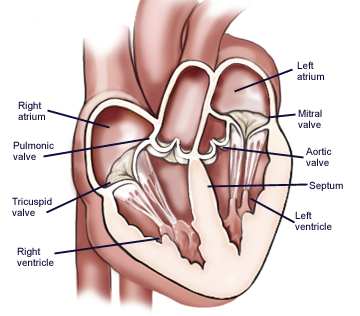
They open and close in response to pressure changes. The valve which allows mixture into the cylinder is the inlet valve.
Q13 Q13 Q13.
Heart valves open and close in response to. The four heart valves open and close in response to pressure changes that occur in the ventricles during each cardiac cycle. When the ventricles relax their pressures drop below those of the atria pulmonary trunk artery and aorta. The four heart valves are the tricuspid pulmonary mitral and aortic.
The valves open and close to let the blood flow in only one directionto pump blood throughout the bodyTo keep blood. During the cardiac cycle heart valves open and close in response to differences in blood pressure on their two sides. The Heart Valves.
Pulmonary semilunar valve Aortic Semilunar Valve Left AV valve or Bicuspid valve or Mitral valve Right AV valve or Tricuspid valve Page 4. Overview of Cardiac Cycle Phases of the Cardiac Cycle 1. Heart valves open and close in response to pressure changes as the chambers contract and relax.
Two types of valves. Atrioventricular valves tricuspid bicuspid semilunar valves pulmonary aortic Atrioventricular valves are forced OPEN as pressure increases in the atria. The two semilunar valves The Pulmonary Semilunar Valve and The Aortic Semilunar Valve prevent backflow into ventricles when ventricles relax.
They open and close in response to pressure changes. Why are the papillary muscles called so. Valves open and close in response to _____ Prevent backflow Each valve ensures the one-way flow of blood by opening to let blood through and then closing to _____________.
4 During the cardiac cycle heart valves open and close in response to what. The heart valves open and close in response to differences in blood pressure on their two sides. When systole occurs the valves close after filling the ventricles then during the diastole the valves open to allow the blood from the ventricles to flow into the pulmenary artery and the aorta.
Valves open and close in response to pressure changes in the heart. Valves act as one way doors to keep blood moving forward. Circulation it is important to understand blood flow through the heart in order to understand overall function of the heart and how changes in.
The AV valves close in response to the ____. Contraction of the ventricles and the resulting rise in ventricular pressure B. Contraction of the ventricles and the resulting drop in ventricular.
Partial pressure gradient changes during systole and diastole cause the opening and closing of the valves. Valve stenosis is when valves narrow and cant open fully while regurgitation is when they cannot close completely. In both instances the heart must work harder to compensate for the faulty valves.
Heart Valves Heart valves function to ensure a one-way flow of blood through the heart. The valves are not made of muscle but rather are composed of sheets of tough connective tissue that act like flaps. The heart valves open and close passively because of pressure differences on either side of the valve.
The hearts valves open and close in response to changes in Free. Unlock to view answer. Q12 Q12 Q12.
Heart valves serve what purpose. Unlock to view answer. Q13 Q13 Q13.
The valve that separates the right atrium and right ventricle is. This forces the semilunar valves to close which prevents blood from entering the ventricles. Blood in the large arteries reverses flow forcing the semilunar valves to close.
The drop in ventricular pressure also allows the AV valves to re-open and a new cycle begins. In both cases as the valves close the openings within the atrioventricular septum guarded by the valves will become reduced and blood flow through the opening will become more turbulent until the valves are fully closed. There is a third heart sound S 3 but it is rarely heard in healthy individuals.
It may be the sound of blood flowing into the atria or blood sloshing back and forth in the ventricle or even tensing. The heart is forced to pump blood with increased force in order to move blood through the stiff stenotic valves. Heart valves can have both malfunctions at the same time regurgitation and stenosis.
When heart valves fail to open and close properly the implications for the heart can be serious possibly hampering the hearts ability to. As the heart muscle contracts and relaxes the valves open and shut. This lets blood flow into the ventricles and atria at alternate times.
Here is a step-by-step description of how the valves work normally in the left ventricle. When the left ventricle relaxes the aortic valve closes and the mitral valve opens. During isovolumetric relaxation what OPENS the AV valves.
With hypertension the ventricular pressure must rise higher to open the semilunar valves. For the same increase in pressure in a normotensive person less blood is ejected in a hypertensive person. Thus the heart of someone with hypertension must work harder to eject the same stroke volume.
Valves open in response to _____ on their two sides. List the chambersvessels that the four valves connect. Chamber ChamberVessel Pulmonary Semilunar Aortic Semilunar Left AV Right AV 3.
The valve which allows mixture into the cylinder is the inlet valve. The one through which the spent gases escape is the exhaust valve. They are designed to open and close at precise moments to allow the engine to run efficiently at all speeds.
The operation is controlled by pear-shaped lobes called cams on a rotating shaft the camshaft driven by a chain a belt or a set of gears from. Each of the cardiac valves A opens and closes in response to changes in pressure. B attaches to the ventricular walls via chordae tendinae.
C ensures one-way blood flow through the heart. D A and C are correct. E All of these are correct.
A medical student examines a valve that has been removed from a heart.